Costa Concordia: Potential Oil Spill Could Cause Italy’s Worst Environmental Disaster in 21 Years

As the crippled luxury cruiser Costa Concordia remains trapped and immobile in the waters off the western coast of Tuscany, government officials and environmentalists are worried about the possible leakage of up to 500,000 gallons of fuel oil within the vessel in the event it tilts off an undersea ledge, slides or moves to any significant degree.
Such a spillage would pollute one of the most beautiful and unspoiled maritime areas in the Mediterranean.
Rescue officials are meanwhile hoping to pump the fuel out in a safe manner, but the ship’s precarious position might make that very difficult.
Fulco Pratesi, founder of the conservation group WWF, wrote in the Corriere della Sera newspaper: We can only hope that the weather remains acceptable, that efforts to stabilize the wreck continue speedily, and that God gives us a hand to preserve what many consider a little Mediterranean paradise.
Luigi Alcaro, the chief of maritime emergencies at Istituto Superiore per la Protezione e la Ricerca Ambientale (ISPRA), the Italian government agency for protection of the environment, told Reuters: If the Costa Concordia slides further down and the fuel begins seeping into the water, we could be talking years and dozens of millions of euros before it can be cleared up.”
Corrado Clini, Italy’s environment minister, warned parliament that the Costa Concordia is carrying enough fuel and oil to compare it to a small tanker, adding that even a minor spillage would be disastrous to the flora and fauna in the region.
Alcaro further said to Reuters: The oil on the ship is very thick and sticky, so you'd have to drill a hole in the hulk and warm it up to make it more fluid and easier to extract. That could be done in about a month for the 13 external tanks on the ship. There are another 10 tanks inside, and those are a lot more difficult to reach… The very worst scenario is having oil slowly leaking out.
Tourism in the nearby coastal city of Giglio would also be badly hurt by a potential fuel leak.
If there's a massive fuel spill, we might as well close everything down, throw away the key and come back in 10 years, said Massimiliano Botti, a local restaurant owner, according to Reuters.
Environmental damage is what concerns us most. If the oil pollutes the coast, we're ruined.
Indeed, the release of oil into the blue seas would represent the worst maritime ecological disaster in Italy in over twenty years and officials would be wise to heed the lessons of that tragedy.
In April 1991, the Amoco Milford Haven, a huge oil tanker exploded, caught on fire and sank off the coast of Genoa, in northern Italy, and spilled 50,000 tonnes of crude oil into the sea, also killing six crew members.
The ship’s First Officer Donatos Lilis later testified in a court hearing: I heard a very loud noise, like iron bars beating against each other. Perhaps the cover of a pump had broken. Then there was an awful explosion.
According to historical accounts, the vessel burned for two days before it actually sank.
According to Alcaro of ISPRA, the clean-up of the Milford Haven disaster was not finished until 2008 (seventeen years after it sank) and the ship is still stuck on the sea bed - making the shipwreck a popular tourist destination for divers.
For the first twelve or so years after the sinking, much of the nearby coasts of Italy and France was polluted.
Lucas Haji-Ioannou and Stelios Haji-Ioannou, the father and son who owned the company that the ship was leased to, faced manslaughter charges in connection with the deaths of the six crewmembers.
However, after a lengthy and torturous series of trials and re-trials that lasted until 2002, the Haji-Ioannous were ultimately acquitted -- a decision that greatly outraged Italian government officials, environmentalists and maritime union chiefs.
© Copyright IBTimes 2025. All rights reserved.





















